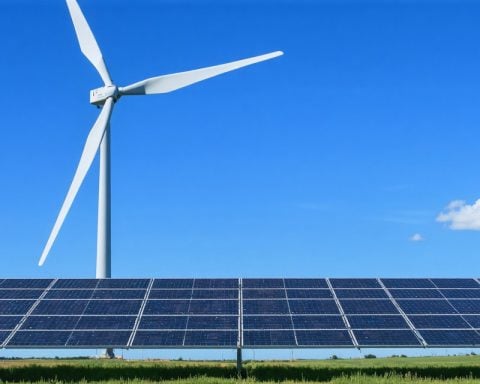- MP Materials Corp is advancing in rare earth production with key initiatives like launching NdPr metal production and trial production of automotive-grade magnets.
- The company secured a major supply deal with a leading automaker, strengthening its position outside China in the rare earth market.
- Financial strategies include extending debt maturities to 2030 and retiring a significant portion of 2026 notes.
- Challenges include falling NdPr prices to $50/kg, elevated production costs, and a $21.5 million inventory write-down, partially offset by a $12.2 million tax credit.
- The CEO’s 2025 vision focuses on growth and resilience, emphasizing increased throughput amid volatile pricing.
- Investment in magnetics technology is positioned to capitalize on rising demand for NdFeB magnets in electrification and AI sectors.
- MP Materials aims to be a pivotal player in the evolving technology landscape, leveraging robust strategies to navigate market volatility.
MP Materials Corp, a stalwart in rare earth production, is crafting a path toward dominance as global industries pivot toward electrification and AI. Like a masterful chess player, the company executed two game-changing moves in Q4 2024: launching NdPr metal production and trial production of automotive-grade magnets, cornerstones of the modern tech revolution.
Imagine a juggernaut fueled by ambition and strategic foresight. By securing a hefty supply deal with a top-tier automaker, MP Materials now energizes three of the five largest automakers outside China, reinforcing its standing as a linchpin in the non-Chinese rare earth ecosystem. As debt maturities drift to the horizon of 2030, the company also smartly retired over 90% of its 2026 notes, illustrating a savvy financial maneuver.
Yet, the journey isn’t without hurdles. The deflationary dip in NdPr prices, plummeting to $50 per kilogram, presses on the bottom line. Elevated production costs and a $21.5 million inventory write-down offer a challenging landscape. However, a silver lining glimmers—a $12.2 million tax credit buffers the storm.
The CEO’s vision for 2025 casts a beacon of growth and resilience, focusing on boosting throughput despite the tempestuous pricing seas. With China tightening its rare earth grip, MP Materials’ robust supply chain emerges as a crucial anchor for industries aiming to tether themselves to stable sources.
Investment in magnetics technology promises a renaissance of profitability, despite near-term operating cost surges. The rare earth titan is poised to ride the wave of demand for NdFeB magnets, which underpin the electrified and AI-driven world.
The takeaway? In a volatile market, MP Materials’s meticulous strategy empowers it to not just survive—but thrive—as a pivotal player shaping the future of technology.
The Rare Earth Revolution: How MP Materials is Shaping the Future of Technology
How-To Steps & Life Hacks
For individuals looking to understand or invest in rare earth materials, here are several strategic steps:
1. Stay Informed About Market Trends: Regularly read up on trends in the rare earth industry. Resources like the Wall Street Journal provide insights into economic impacts and market movements.
2. Diversification in Investments: Consider diversifying your portfolio with rare earth-focused companies, but balance it with other industry sectors to mitigate risk.
3. Follow Supply Chain Developments: Understanding the dynamics of rare earth supply chains can provide insights into the industry’s future—MP Materials, for example, has a stable non-Chinese supply chain.
Real-World Use Cases
Rare earth materials are critical in several applications:
– Electric Vehicles (EVs): NdPr metals are used in the motors of electric vehicles, helping them achieve better performance and efficiency.
– Wind Turbines: Rare earth elements like NdFeB magnets are integral in converting wind energy more efficiently.
– Consumer Electronics: From smartphones to laptops, rare earths ensure the miniaturization and enhancement of device capabilities.
Market Forecasts & Industry Trends
The global rare earth elements market is expected to grow significantly due to increasing demand in electronics, electric vehicles, and renewable energy sectors. Market Research forecasts suggest a CAGR of around 10% from 2021 to 2028.
Reviews & Comparisons
MP Materials is often compared to other players in the rare earth space:
– Lynas Rare Earths: While it is one of the largest processors outside of China, Lynas’s supply chain doesn’t match MP Materials’ extensive reach into the automotive sector.
– China’s dominance: China still holds the majority market share, but companies like MP Materials are vital in providing non-Chinese alternatives.
Controversies & Limitations
– Environmental Concerns: The extraction and processing of rare earth elements can be environmentally damaging. It involves radioactivity risks and extensive waste production.
– Market Volatility: The rare earth market is susceptible to pricing swings, as seen with the decrease in NdPr prices to $50 per kilogram.
Features, Specs & Pricing
– NdPr Products: MP Materials’ produces highly sought-after NdPr metals with applications in various high-tech and green tech industries.
Security & Sustainability
Ensuring a secure and sustainable supply of rare earth elements is critical:
– Non-Chinese Supply Chains: MP Materials’ facilities in the U.S. offer stability amid geopolitical tensions.
– Sustainability Practices: Innovations in recycling rare earths and improving mining processes aim to reduce environmental impact.
Insights & Predictions
As the demand for green technologies and AI expands globally, MP Materials is expected to see an increase in demand for its products despite market volatility.
Pros & Cons Overview
Pros:
– Strong strategic positioning and diversified supply chain.
– Heavy investment in technology and development.
– Key partnerships with major automakers.
Cons:
– Subject to fluctuations in global market prices.
– Environmental impact of extraction processes.
Conclusion and Actionable Recommendations
– Invest Wisely: Given the volatile nature of rare earth materials, consider carefully the timing and range of your investments.
– Expand Knowledge: Stay updated on technological advancements in magnetics and other applications of rare earths.
– Sustainability Focus: Support companies adopting green practices in rare earth extraction and processing.
For more on investing and emerging industries, visit the Forbes website.




















